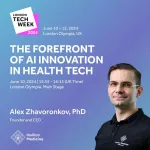(Press-News.org) Pathology experts engineered an ultrasensitive test capable of detecting a highly specific biomarker found in multiple common cancers
In collaboration with cancer researchers across the country and the globe, the team evaluated the tool’s ability to detect the biomarker in ovarian cancer, gastroesophageal cancer, colon cancer, and other cancers
Diagnostic assays have potential for early cancer detection, monitoring, and prognostics
Marker ‘LINE-1 ORF1p’ is a protein encoded by a human transposon that has further potential applications in tissue diagnostics and may also facilitate treatment of cancers for which no accurate biomarkers exist
Diagnostic tools for timely, accurate and inexpensive early cancer detection that can assess risk or monitor response to treatment could help patients get the care they need faster and improve existing care strategies. But current cancer assessment methods have limited specificity and sensitivity and can be prohibitively expensive. In a study led by investigators from Mass General Brigham, the Wyss Institute for Biologically Inspired Engineering at Harvard University and Dana-Farber Cancer Institute, in collaboration with researchers from across the country and beyond the U.S., researchers developed a low-cost, ultrasensitive blood test to detect minute levels of a cancer biomarker that is highly specific to multiple common cancers. Each test can be performed with merely half a drop of blood (25 microliters). The tool showed promise for early cancer detection and disease monitoring, and could potentially be used in conjunction with other tools for detection, risk stratification and treatment. Results are published in Cancer Discovery.
“Cancer biomarker detection is a burgeoning area of research and is still a young field,” said co-corresponding author David Walt, Ph.D., of the Department of Pathology at Brigham and Women’s Hospital, a founding member of Mass General Brigham. Walt is also a core faculty member at the Wyss Institute. “Our results show that we can detect levels of this pan-cancer biomarker in the blood of patients with many types of cancers.”
The new study leverages a single-molecule-based detection technology known as SIMOA that was developed by the Walt lab. The test is designed to detect the open reading frame 1 protein (ORF1p), a transposable element protein that’s known to occur in many cancers but not in corresponding normal tissue, and that can indicate high risk of cancer lethality. Researchers have long sought a sensitive, accurate test to detect ORF1p. The authors describe their first investigation of the test as a pilot experiment that wound up working better than they had imagined, which was followed by a series of engineering improvements and iterations in patient samples.
“We were shocked by how well this test worked in detecting the biomarker’s expression across cancer types,” said lead author Martin Taylor, M.D., Ph.D., of the Department of Pathology at Massachusetts General Hospital, the other founding member of Mass General Brigham. “It’s created more questions for us to explore and sparked interest among collaborators across many institutions.”
Teaming up with investigators across Mass General Brigham, Dana-Farber, Beth Israel Deaconess, and MIT in Boston and from Rockefeller University, University of Pennsylvania, University of Washington (Seattle), Johns Hopkins, Groningen (Netherlands), and Canon Medical, the researchers tested blood samples from patients with different types of cancers, including ovarian and colorectal cancer. The ultrasensitive assessment tool successfully quantified ORF1p in cancer patient blood samples, but only in very rare ‘healthy’ patients, supporting the specificity for cancer detection. Studies in tissue samples from ~200 colon cancer and 75 esophageal biopsies, obtained from patients at different disease stages, showed that ORF1p tissue expression was prevalent in carcinomas and high-risk precursor lesions.
“Our results bolster the emerging idea that ORF1p expression is a ‘hallmark of cancer’ expressed starting early in the disease process. Pervasive expression of ORF1p in carcinomas and the lack of expression in normal tissues makes ORF1p unlike other protein biomarkers, which have normal expression levels. This unique biology makes it highly specific,” said Taylor.
A limitation of the study is that the results don’t provide key pieces of information, such as the location of the cancerous tissues in the body. In addition, the ultrasensitive assessment tool isn’t successful in identifying all cancers and their subtypes. The team envisions that the tool could be used in addition to other tests to improve overall early detection testing methods, and to allow doctors to monitor patient response to cancer therapy in real time and make adjustments if needed.
“The test is very specific, but it doesn’t tell us enough information to be used in a vacuum,” said Walt. “It’s exciting to see the early success of this ultrasensitive assessment tool, but there is more work to be done.”
The study’s pathology researchers are now working with clinicians to study the test’s accuracy in larger trial cohorts and different patient populations in order to understand if the assessment of the ORF1p biomarker would be useful for the care of their patients. They are also working to determine whether the biomarker can be used to stratify the risk of cancer in patients.
“We’ve known since the 1980s that transposable elements were active in some cancers, and nearly 10 years ago we reported that ORF1p was a pervasive cancer biomarker, but, until now, we haven’t had the ability to detect it in blood tests,” said co-corresponding author Kathleen Burns, M.D., Ph.D., Chair of the Department of Pathology at Dana-Farber. “Having a technology capable of detecting ORF1p in blood opens so many possibilities for clinical applications. We were fortunate to assemble this tremendous team to push the limits of these assays and obtain and test these precious samples. There’s a lot of excitement as our work continues.”
Authorship: Co-first authors are Martin S. Taylor and Connie Wu. Co-authors include Peter C. Fridy, Stephanie J. Zhang, Yasmeen Senussi, Justina C. Wolters, Tatiana Cajuso, Wen-Chih Cheng, John D. Heaps, Bryant D. Miller, Kei Mori, Limor Cohen, Hua Jiang, Kelly R. Molloy, Brian T. Chait, Michael G. Goggins, Irun Bhan, Joseph W. Franses, Xiaoyu Yang, Mary-Ellen Taplin, Xinan Wang, David C. Christiani, Bruce E. Johnson, Matthew Meyerson, Ravindra Uppaluri, Ann Marie Egloff, Elyssa N. Denault, Laura M. Spring, Tian-Li Wang, Ie-Ming Shih, Jennifer E. Fairman, Euihye Jung, Kshitij S. Arora, Osman H. Yilmaz, Sonia Cohen, Tatyana Sharova, Gary Chi, Bryanna L. Norden, Yuhui Song, Linda T. Nieman, Leontios Pappas, Aparna R. Parikh, Matthew R. Strickland, Ryan B. Corcoran, Tomas Mustelin, George Eng, Omer H. Yilmaz, Ursula A. Matulonis, Steven J. Skates, Bo R. Rueda, Ronny Drapkin, Samuel J. Klempner, Vikram Deshpande, David T. Ting, Michael P. Rout, and John LaCava. Co-senior authors are David R. Walt and Kathleen H. Burns.
Disclosures: MST and JL have equity in ROME therapeutics. . LMS declares the following relationships: Consultant/advisory board: Novartis, Puma, G1 therapeutics, Daiichi Pharma, Astra Zeneca,Institutional research support: Phillips, Merck, Genentech, Gilead, Eli Lilly. SJK declares Consulting/advisory: Eli Lilly, Merck, BMS, Novartis, Astellas, AstraZeneca, Daiichi- Sankyo, Novartis, Sanofi-Aventis, Natera, Exact Sciences, Mersana. Stock/Equity: Turning Point Therapeutics, Nuvalent. DRW has a financial interest in Quanterix Corporation, a company that develops an ultra-sensitive digital immunoassay platform. He is an inventor of the Simoa technology, a founder of the company and also serves on its Board of Directors. KHB declares relationships with Alamar Biosciences, Genscript, Oncolinea/PrimeFour Therapeutics, ROME Therapeutics, Scaffold Therapeutics, Tessera Therapeutics, and Transposon Therapeutics. MST and KHB receive royalties from sales of ORF1p antibodies and MST, CW, PCF, KRM, BTC, MPR, JL, DRW, and KHB are inventors on a patent related to this work.
Funding: This work was supported by the National Institutes of Health (R01GM130680, K08DK129824, F32EB029777, R01CA240924, U01CA228963, P41GM109824, T32CA009216, U01CA233364, U2CCA271871, U01CA152990, R01GM126170, P50CA228991, P50CA240243, P30CA006516), Break Through Cancer, Earlier.Org, Minnesota Ovarian Cancer Alliance, Department of Defense (W81XWH-22-1-0852), Canary Foundation, Gray Foundation, The Concord (MA) Detect Ovarian Cancer Early Fund, Good Ventures (Open Philanthropy Project), Friends of Dana-Farber Cancer Institute, Dana-Farber Cancer Institute, the Dana-Farber/Harvard Cancer Center (DF/HCC), ACD-Biotechne, Robert L. Fine Cancer Research Foundation, Worldwide Cancer Research grant 19-0223, Robertson Therapeutic Development Fund, Nile Albright Research Foundation, Vincent Memorial Research Foundation, Stand Up to Cancer Gastric Cancer Interception Research Team Grant (SU2C-AACR-DT-30-20), American Association for Cancer Research, the Scientific Partner of SU2C.
Paper cited: Taylor, M. et al. “Ultrasensitive detection of circulating LINE-1 ORF1p as a specific multi-cancer biomarker” Cancer Discovery. DOI: https://doi.org/10.1101/2023.01.25.525462
###
END
Ultrasensitive blood test detects ‘pan-cancer’ biomarker
Pathology experts engineered an ultrasensitive test capable of detecting a highly specific biomarker found in multiple common cancers
2023-10-05
ELSE PRESS RELEASES FROM THIS DATE:
Insilico Medicine founder and CEO Alex Zhavoronkov, Ph.D., to present on AI drug discovery at LSX Nordic Congress
2023-10-05
Alex Zhavoronkov, Ph.D., founder and CEO of Insilico Medicine (“Insilico”) will present at the 6th LSX Nordic Conference happening in Copenhagen Oct. 10-11. Zhavoronkov, a leader in generative artificial intelligence (AI) technologies for drug discovery and biomarker development, will present on Oct. 11, 2pm CET on “‘How Artificial Intelligence is Shaping the Future of Drug Discovery, Design, and Development.”
The LSX Nordic Congress is a leading strategy, investment and partnering conference for the Nordic region connecting life science and healthcare ...
Grape consumption benefits eye health in human study of older adults
2023-10-05
In a recent randomized, controlled human study, consuming grapes for 16 weeks improved key markers of eye health in older adults. The study, published in the scientific journal Food & Function looked at the impact of regular consumption of grapes on macular pigment accumulation and other biomarkers of eye health.[1] This is the first human study on this subject, and the results reinforce earlier, preliminary studies where consuming grapes was found to protect retinal structure and function.[2]
Science has shown that an aging population has a higher risk of eye disease and vision problems. Key risk factors for eye disease include 1) oxidative ...
Don’t feel appreciated by your partner? Relationship interventions can help
2023-10-05
When we’re married or in a long-term romantic relationship, we may eventually come to take each other for granted and forget to show appreciation. A new study from the University of Illinois Urbana-Champaign finds that it doesn’t have to stay this way.
The study examined why perceived gratitude from a spouse or romantic partner changes over time, and whether it can be improved through relationship intervention programs.
“Gratitude almost seems to be a secret sauce to relationships, and an important piece to the puzzle of romantic relationships that hasn’t gotten much attention ...
Study confirms age of oldest fossil human footprints in North America
2023-10-05
The 2021 results began a global conversation that sparked public imagination and incited dissenting commentary throughout the scientific community as to the accuracy of the ages.
“The immediate reaction in some circles of the archeological community was that the accuracy of our dating was insufficient to make the extraordinary claim that humans were present in North America during the Last Glacial Maximum. But our targeted methodology in this current research really paid off,” said Jeff Pigati, USGS research geologist ...
More than 10,000 pre-Columbian earthworks remain hidden throughout Amazonian forests
2023-10-05
More than 10,000 Pre-Columbian archaeological sites likely rest undiscovered throughout the Amazon basin, estimates a new study. The findings, derived from remote sensing data and predictive spatial modeling, address questions about the influence of pre-Columbian societies on the Amazon region. “The massive extent of archaeological sites and widespread human-modified forests across Amazonia is critically important for establishing an accurate understanding of interactions between human societies, Amazonian forests, and Earth’s climate,” write the authors. ...
New, independent ages confirm antiquity of ancient human footprints at White Sands
2023-10-05
New radiocarbon (14C) and optically simulated luminescence ages have confirmed the controversial antiquity of the ancient human footprints discovered in White Sands National Park, and reported in a study in 2021. Addressing the widespread criticism of their previous study, researchers report that the independent ages from multiple resolved sources conclusively show that the footprints were left behind between roughly 23,000 and 20,000 years ago, demonstrating that humans were present in southern North America during the Last Glacial ...
Special Issue: Ancient DNA
2023-10-05
In this Special Issue of Science, three Reviews highlight how recent advances in the field of ancient DNA have greatly advanced our understanding of the evolutionary history of many plants and animals, including our own species. “This special issue examines the changing landscape of how ancient DNA (aDNA) is studied today, including previously untapped sources, improvements in technology, and ethical challenges, and what we’ve learned about ourselves though ancient DNA,” write Corinne Simonti and Madeleine ...
What are the risks of radioactive wastewater release – the next of which is October 5th – from Fukushima Daiichi nuclear plant?
2023-10-05
Wastewater release from the Fukushima Daiichi nuclear plant in Japan is expected to have negligible effects on people and the ocean, Jim Smith and colleagues report in a Perspective. The planned releases of radioactive wastewater, 350 million gallons of which has been stored at the site since the 2011 earthquake and tsunami that triggered the Fukushima plant’s meltdown, began in August 2023 and are expected to continue for perhaps the next 30 years. The second release is scheduled to start on October 5th. While the scheduled releases have sparked international concern, Smith et al. discuss the science behind the risks and ...
Discovery made about Fischer Tropsch process could help improve fuel production
2023-10-05
A fundamental discovery about the Fischer Tropsch process, a catalytic reaction used in industry to convert coal, natural gas or biomass to liquid fuels, could someday allow for more efficient fuel production.
Washington State University researchers discovered previously unknown self-sustained oscillations in the Fischer Tropsch process. They found that unlike many catalytic reactions which have one steady state, this reaction periodically moves back and forth from a high to a low activity state. The discovery, reported in Science, means that these well-controlled oscillatory states might be used in the future to enhance the reaction rate and the yields of desired ...
New discovery may ‘unlock’ the future of infectious disease and cancer treatment
2023-10-05
University of Birmingham News Release
STRICTLY EMBARGOED UNTIL 14.00 Thursday 5th October ET 2023/ 19.00 Thursday 5th October UK 2023
Researchers have identified a ‘guard mechanism’ for a protein which attacks microbes in infected cells, opening the possibility of new treatments for Toxoplasma, Chlamydia, Tuberculosis and even cancer.
A study, led by the University of Birmingham and published today (5th October) in Science has discovered the lock and key mechanism that controls the attack protein GPB1. GBP1 is activated during ...
LAST 30 PRESS RELEASES:
New study overturns long-held model of how plants coordinate immune responses.
New AI model predicts disease risk while you sleep
Scientists discover molecular ‘reshuffle’ and crack an 80-year-old conundrum
How stressors during pregnancy impact the developing fetal brain
Electrons lag behind the nucleus
From fungi to brain cells: one scientist's winding path reveals how epigenomics shapes neural destiny
Schizophrenia and osteoporosis share 195 genetic loci, highlighting unexpected biological bridges between brain and bone
Schizophrenia-linked genetic variant renders key brain receptor completely unresponsive to both natural and therapeutic compounds
Innovative review reveals overlooked complexity in cellular energy sensor's dual roles in Alzheimer's disease
Autism research reframed: Why heterogeneity is the data, not the noise
Brazil's genetic treasure trove: supercentenarians reveal secrets of extreme human longevity
The (metabolic) cost of life
CFRI special issue call for papers: New Frontiers in Sustainable Finance
HKU Engineering scholar demonstrates the smallest all-printed infrared photodetectors to date
Precision empowerment for brain "eavesdropping": CAS team develops triple-electrode integrated functional electrode for simultaneous monitoring of neural signals and chemical transmitters during sleep
Single-capillary endothelial dysfunction resolved by optoacoustic mesoscopy
HKU three research projects named among ‘Top 10 Innovation & Technology News in Hong Kong 2025’ showcasing excellence in research and technology transfer
NLRSeek: A reannotation-based pipeline for mining missing NLR genes in sequenced genomes
A strand and whole genome duplication–aware collinear gene identification tool
Light storage in light cages: A revolutionary approach to on-chip quantum memories
Point spread function decoupling in computational fluorescence microscopy
BacPhase: Long-insert paired-end sequencing for bin marker construction and genome phasing
GmWOX1 regulates the mediolateral polarity of compound leaves in soybean
ChargeFabrica: An open-source simulation tool that aims to accelerate search for high performance perovskite solar cells
High levels of ADAR overexpression induce abundant and stochastic off-target RNA editing in rice protoplasts
On-demand upgraded recycling of polyethylene and construction of sustainable multifunctional materials based on the "LEGO" strategy
New "Stomata in-sight" system allows scientists to watch plants breathe in real-time
Anorexia nervosa may result in long-term skeletal muscle impairment
Narrative-based performance reviews deemed fairest by employees
New insights reveal how advanced oxidation can tackle emerging water pollutants
[Press-News.org] Ultrasensitive blood test detects ‘pan-cancer’ biomarkerPathology experts engineered an ultrasensitive test capable of detecting a highly specific biomarker found in multiple common cancers


